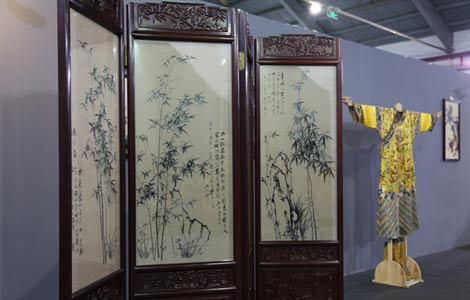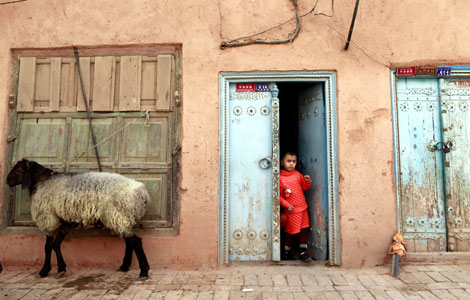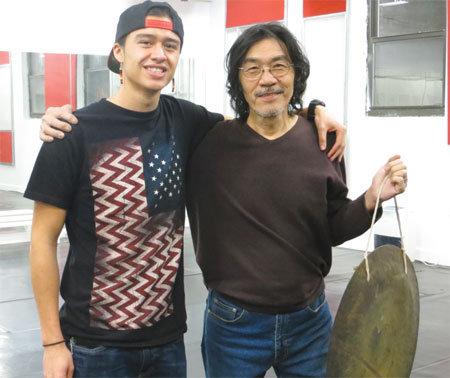Chinatown gets taste of Lakota life
Updated: 2013-11-08 12:58
By Caroline Berg in New York (China Daily USA)
|
||||||||
|
Chen Dance Center director H.T. Chen (right) discovered Lakota artist Frank Waln at an arts conference last year and invited Waln to create a piece for his company. Caroline Berg / China Daily |
He is a 24-year-old Native American from a reservation in "the middle of nowhere South Dakota." And now he has partnered with a Chinatown-based dance company with performances aimed at getting across a message.
"People don't even know we're alive - we're mascots, we're Halloween costumes," said artist Frank Waln, referring to himself and other Native Americans. "No, we're living, we're breathing, and that's a big part of our performance."
Waln has partnered with the Chen Dance Center for two performances on Friday and Saturday of "Crossroads: Hip Hop & Hoops An Indigenous Experience."
His original work combines electronic music and hip-hop with traditional music and dance to tell stories about his life on the reservation. This includes Native American Hoop Dance, a form of storytelling that incorporates anywhere from one to 30 hoops as props to create both static and dynamic formations representing various animals, symbols and other storytelling elements.
"I saw him perform last year at a conference and I thought that he would be a very nice example for our community," said H.T. Chen, director of the dance center, who spent the summer of 1976 living and working with a Navajo tribe community in the southwest Four Corners region.
The Chen Dance Center is divided into three programs: a touring modern dance company dedicated to the created of innovative works and offering quality educational programming; a year-round community performing arts school; and a professional performing arts venue that supports the work of emerging artists through production services and series.
"Once I started talking with Chen Dance Center and we started getting the cultural dialogue set up, it took on a lot more meaning for me because we're both coming from very unique communities of very marginalized people," Waln said. "Having this cross-cultural dialogue I think is really important for solidarity and bringing strength to our communities and awareness."
Although he grew up listening to the traditional music, Waln said today's reservation youth listen to either hip hop music or heavy metal - a far cry from his mother's generation that favored more country and rodeo culture. It wasn't until one evening on a walk with his mother along one of the reservation's many gravel roads that Waln's eye caught sight of something flash on the side of the road.
"I was like, 'What the heck?' " Waln said.
He found a scratched up CD lying face down. He picked it up, turned it over and saw a white face with a backwards "E" on the cover.
Without much hope the mysterious disc would play, Waln took it home, popped it in his CD player and out came Eminem.
"I was just blown away," Waln said about the famous rapper's music. "It was like he was telling my story, and it was a powerful, powerful connection for me."
Like Eminem, Waln said he grew up in a dysfunctional home environment, where he was a witness to domestic violence, as well as alcohol and drug abuse, and his parents divorced when he was 4.
At the same time he began listening to Eminem, Waln said he was dabbling in poetry.
"It all kind of locked up and connected," Waln said. "At that moment is when I fell in love with hip hop and I started writing rhymes."
In 2010, Waln and his group Nake Nula Waun - "I am always ready, at all times, for anything" - created and produced their first album Scars and Bars using just a keyboard and a laptop, according to Indian Country Today Media Network.com. Since then, Waln has taken on a variety of arts projects, and has won a number of Native American Music Awards and Rockwired Radio Music Awards. His latest music video, "AbOriginal," is now available to view on YouTube.
Throughout his time at the Chen Dance Center this week, Waln has participated in the company's after-school art education program with fourth and fifth grade students to write together a poem that reflects the students' Chinese backgrounds, which they put together with dance and music.
"Through music, through stories, it's easier to connect on a basic human emotional level," Waln said. "They may know nothing of where I come from, I may know nothing of where they come from, but because of that connection between the music, we're able to relate, and then the dialogue starts, and then that's where the education starts."
Now in Chicago on a Gates Millennium Scholarship studying audio design and production at Columbia College, Waln said he hopes his work will also inspire his own community.
"I'm also working toward my people being happy, healthy and respected, because there's so much dysfunction in our community," said Waln, who speaks to youth on the occasions he returns to his native Rosebud Sioux Reservation.
"There's so much change that needs to happen back home," he said. "No one's going to save us. We have to do it ourselves. We have to take that initiative and have that initiative to want to help ourselves, want to save ourselves, and then collectively that will bring our community back together.
carolineberg@chinadailyusa.com
(China Daily USA 11/08/2013 page11)

 Kerry to join Iran nuclear talks in bid to reach deal
Kerry to join Iran nuclear talks in bid to reach deal
 Politicians court US-Asians amid anti-China sentiment
Politicians court US-Asians amid anti-China sentiment
 Britain remembers war dead
Britain remembers war dead
 Stolen newborn returned to family
Stolen newborn returned to family
 TCM firms should 'learn rules of West'
TCM firms should 'learn rules of West'
 Artists see big picture in CBD's art zone
Artists see big picture in CBD's art zone
 Twitter shares soar in NYSE debut
Twitter shares soar in NYSE debut
 Fly with the Jetman
Fly with the Jetman
Most Viewed
Editor's Picks

|

|

|

|

|

|
Today's Top News
Lenovo profit surges on smartphone, tablet sales
Houston and Shenzhen step up business
Bank exec describes meeting with Li Keqiang
CCBOT finds platform to tackle US market
BlackBerry could pay $250m break fee
China should allow for higher inflation: economist
CIA paying AT&T to provide call records - NYT
Li vows growth, reform balance
US Weekly

|

|







